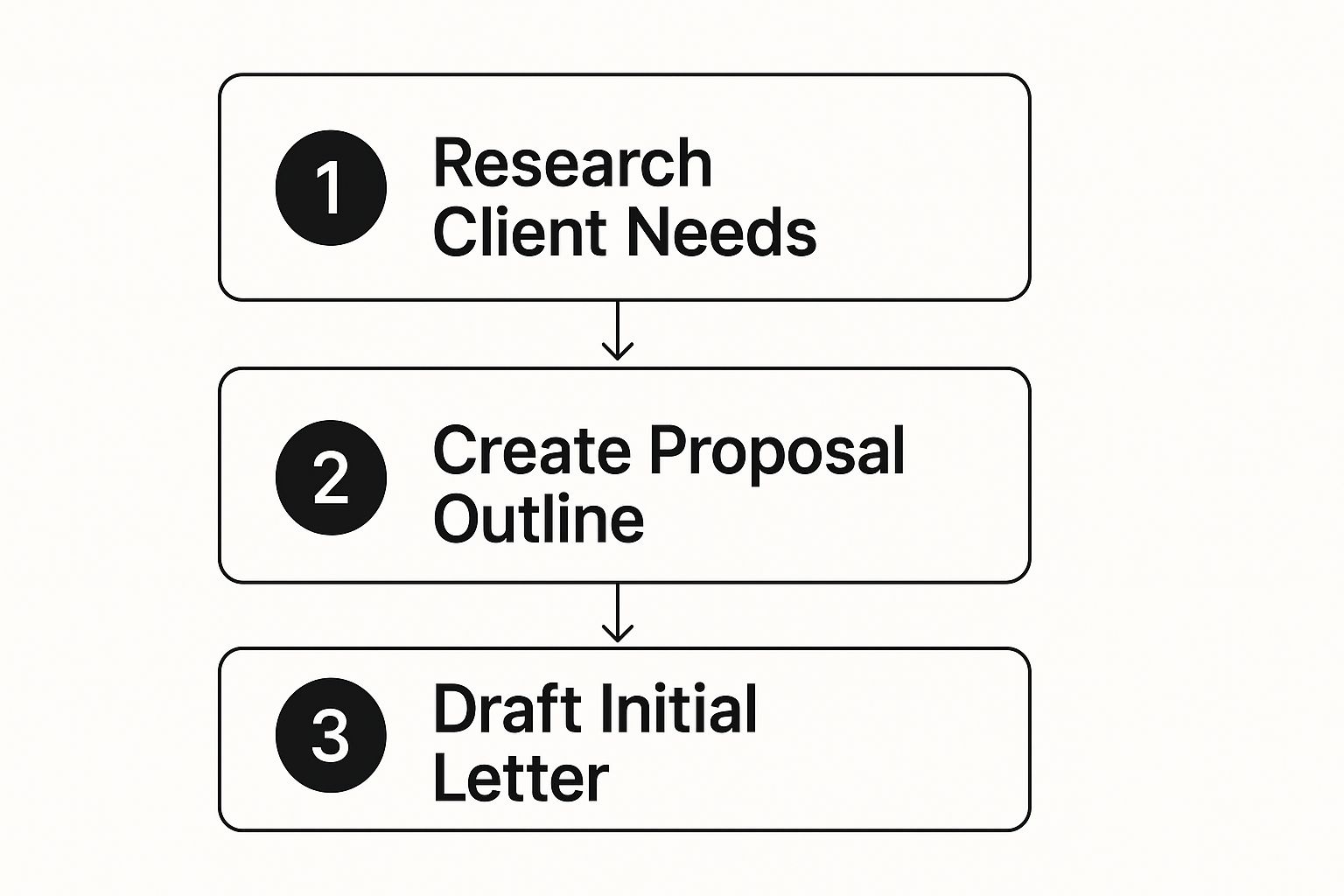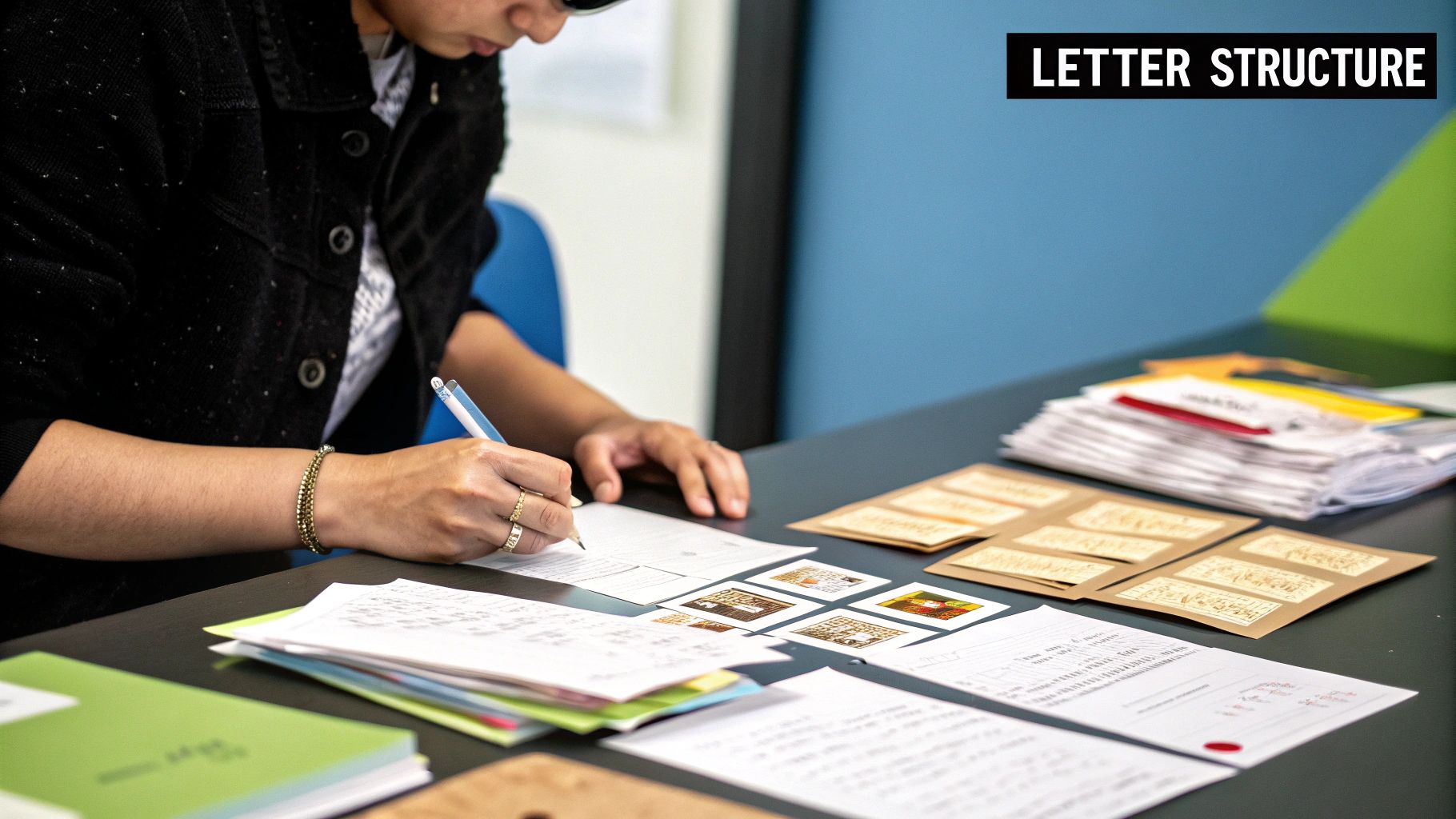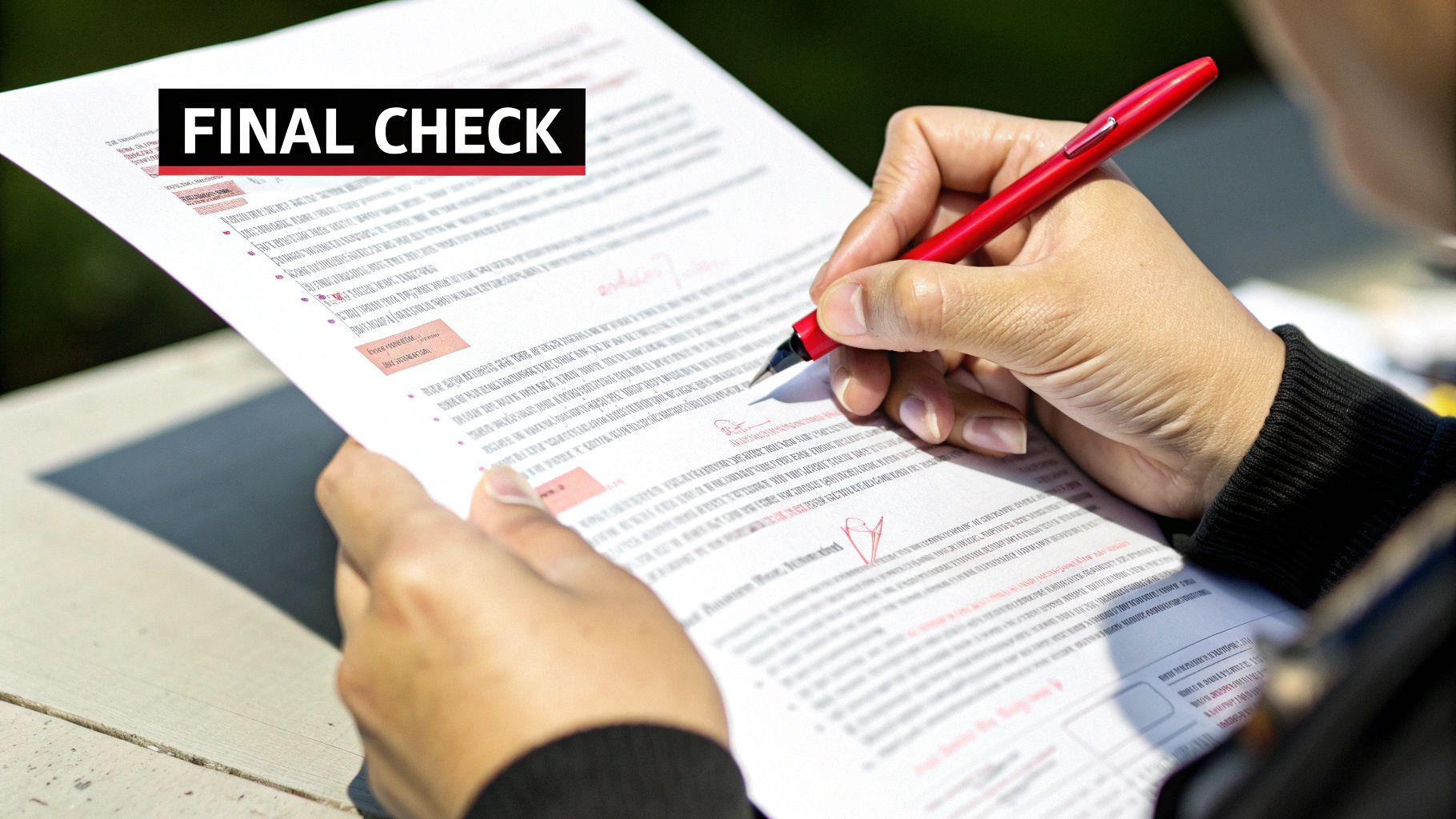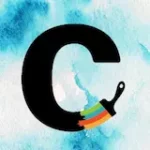So, you've got a killer idea. The first step in turning that idea into a reality is getting it down on paper—not just as a jumble of notes, but as a structured, persuasive proposal letter. This isn't just about explaining your concept; it's about making it so compelling that the person reading it can't help but say "yes."
Laying the Groundwork for a Winning Proposal
Before you even think about opening a new document, you need to do the real work. A great proposal is built on a solid foundation of research and a super clear objective. Honestly, skipping this part is like trying to build a house without a blueprint. It's a recipe for disaster.
The goal here is to get inside your reader's head. You want to understand their world so well that your proposal feels like it was written just for them, speaking directly to their specific needs and pain points.
This means going way beyond a quick skim of their website. You have to dig in. What have they been celebrating lately? What challenges are they facing? Who are the actual people making the decision, and what do they care about? Getting this right allows you to tailor every single word for maximum impact.
Defining Your Core Purpose and Value
Once you know your audience, it's time to get brutally honest about what you're bringing to the table. What makes your offer different? This is your value proposition—the one clear reason they should pick you. It needs to be sharp and answer the question: "What specific, valuable outcome will I deliver for them?"
For example, don't just say, "We offer marketing services." That's generic. A much stronger pitch is, "We help B2B tech startups boost qualified leads by 30% in six months with a targeted content strategy." See the difference? It's specific, focused on results, and immediately shows your value.
This kind of clarity is crucial, especially when you're up against tough competition. Think about it: average grant proposal acceptance rates can be as low as a brutal 10%. A compelling, well-researched story is what makes you stand out.
A proposal isn't just a document; it’s a business plan for your reader's success. Frame every section around the value they will receive, not just the services you will provide.
This strategic approach is a lot like preparing to pitch for funding. If you're looking for capital, our guide on how to pitch investors has some great, related tips on building a persuasive case. And for anyone targeting educational funding, good resources on grant writing for schools can offer expert advice to help you secure those critical funds.
Structuring Your Proposal for Maximum Impact
A winning proposal is more than just a list of services and prices. It’s a story. It’s your chance to walk your client from the problem they’re wrestling with directly to your perfect-fit solution. Forget those rigid, one-size-fits-all templates—the best structure tells a compelling story, with their business as the hero.
Think of it this way: your proposal's architecture has to be intentional. It needs a hook that grabs their attention right away, a body that clearly lays out your game plan, and a closing that makes them want to say "yes" on the spot. Each section should flow naturally into the next, building momentum and trust as they read.
The Anatomy of a Powerful Proposal
I like to think of a great proposal in three acts.
First, your intro needs to land with impact, showing you genuinely get their specific problem. Next, the body is where you shine, detailing your unique solution, what you'll deliver, and the investment needed. Finally, the conclusion wraps it all up, hammering home the value and giving them a crystal-clear next step.
This whole process is built on a solid foundation of research and outlining, which leads to a powerful final draft.

The problem statement is your hook, and it has to be sharp. It's where you prove you've done your homework. For instance, instead of a vague statement like, "Your company needs better marketing," try something that shows you've dug in: "Your Q3 report showed a 15% drop in lead conversion, and our analysis points to outdated messaging on key landing pages." See the difference? One is generic, the other shows you’ve already started solving the problem.
To really nail this planning stage, a creative brief template can be a lifesaver. It forces you to get all your thoughts organized before you even think about writing, acting like a compass for the entire proposal.
Core Components of a Proposal Letter
No matter the industry, every solid proposal is built from the same essential blocks. Getting these components right is the key to creating a document that's both professional and persuasive.
Here’s a breakdown of the must-have sections and what each one is meant to accomplish.
| Component | Purpose | Key Information to Include |
|---|---|---|
| Intro & Problem | Grab attention and show you understand their specific challenge. | Acknowledge their pain point; use specific data or observations. |
| Proposed Solution | Explain how you will solve their problem. | Detail your methodology, unique approach, and strategy. |
| Scope & Deliverables | Set clear expectations and prevent scope creep. | List exactly what you will do and what they will physically receive. |
| Timeline | Provide a realistic schedule and manage expectations. | Key milestones, project phases, and estimated completion dates. |
| Pricing & Terms | Build trust through transparency about the investment. | Clear cost breakdown, payment schedule, and terms of service. |
| Call to Action | Make it easy for them to take the next step. | A clear, direct instruction (e.g., "Click here to approve"). |
Nailing this structure makes your proposal easy to follow and hard to refuse.
A proposal's structure is a lot like a closing argument in court. You present the facts (the problem), introduce your evidence (your solution), and make a compelling closing statement (the call to action) to win your case.
For a bit more inspiration on laying out your document for readability and impact, check out these standout cover letter format examples. Many of the same principles apply. Mastering this flow is a huge part of learning how to draft a proposal letter that actually closes deals.
Writing Persuasive Content That Truly Connects

Okay, you've got the structure down. Now for the hard part: filling it with words that actually convince someone to say "yes." This is where the real magic happens.
The biggest mistake I see? Proposals that are all "me, me, me." You have to flip the script. Stop thinking, "Here's what I can do," and start framing everything as, "Here's what this will do for you." That single shift in perspective is what separates a proposal that gets filed away from one that gets signed.
Every sentence, every bullet point, should be a billboard for the value they’re getting. Instead of just listing your services, show how they solve their most frustrating problems. You're not just a vendor; you're their guide to a better future. Tell that story.
Finding a Client-Centric Tone
This goes way beyond sprinkling the word "you" throughout the document. It's about genuine empathy. You need to show them you get it. Acknowledge their pain points, validate their goals, and then—and only then—position your plan as the clear, confident way forward.
Ditch the corporate jargon. It just creates distance. Write like you're talking to a real person across the table. Be professional, of course, but be approachable. The goal is connection.
Your tone should scream confidence, not arrogance. How? Back up every single claim with proof. A specific data point, a quick example from a past project, a mini-case study. This transforms your proposal from a document of promises into a credible, actionable plan.
A great proposal should feel less like a sales pitch and more like the first strategy session. The reader should walk away feeling like you're already on their team, not just another person trying to get their money.
Weaving a Compelling Narrative
Believe it or not, the best proposals tell a story. It's a simple one, but it's powerful because it makes your client the hero.
Here’s the basic plot:
- The Problem: Kick things off by clearly laying out the challenge you uncovered during your research. Show them you’ve been paying attention.
- The Turning Point: This is where you come in. Introduce your solution as the catalyst for change, the thing that will turn everything around.
- The Resolution: Paint a clear picture of what success looks like. Describe the tangible results and positive outcomes they can expect once they work with you.
This storytelling framework is incredibly effective. It's the same principle behind powerful brand identities, which is crucial when developing branding services for small businesses that need to make a splash. When you write this way, your proposal becomes more than just informative—it becomes memorable and genuinely persuasive.
Using Data to Build Unshakable Credibility

Anyone can make a promise. A strong proposal, however, moves beyond empty claims and offers undeniable proof. In a world full of noise, hard evidence is your best friend for building trust. This is where you anchor your persuasive language in cold, hard facts, making your solution feel less like a gamble and more like a smart investment.
Think about it. Weaving data into your story transforms a vague benefit into a tangible outcome. Instead of just saying you can "increase engagement," you show them how. Tell them, "similar clients saw an average 25% jump in user interaction within three months." That kind of specificity is what makes your claims believable and sets real, solid expectations.
Backing Up Your Claims With Proof
Evidence isn't just about throwing numbers on a page. It's about painting a complete picture of reliability and past success. The best way to do this is by mixing both quantitative and qualitative proof.
Here's what I've seen work best:
- Case Studies: Don't just list what you did. Tell a story. Briefly lay out a past client's initial problem, walk through the solution you implemented, and—most importantly—share the specific, measurable results you delivered. It's storytelling with a point.
- Client Testimonials: A powerful quote from a happy client can do more heavy lifting than pages of your own writing. I always try to pick testimonials that tackle a common concern head-on or perfectly highlight a key strength.
- Data Projections: Use a mix of industry benchmarks and your own performance data to create realistic forecasts. This isn't about pulling numbers out of thin air; it shows you've actually thought through the potential ROI for your client.
Don't just drop data and run. You have to connect the dots for them. Tie every statistic or case study directly back to their specific goals. Make it painfully obvious how your past wins will translate into their future success.
Funders and decision-makers now expect this level of detail. It's no longer a "nice to have." Including stats like community demographics, your own success rates, and solid projections has become essential for being taken seriously.
Of course, demonstrating your impact means you have to track it first. If you're wondering how to get a handle on those numbers, our guide on how to measure marketing effectiveness is a great place to start. Getting this right is what separates a proposal that gets a "maybe" from one that gets a "yes."
Using the Right Tools for Your Proposal Workflow
Let's be honest: manually drafting, tracking, and managing every proposal is a surefire way to burn out and let good opportunities slip through your fingers. The pros aren't grinding it out with spreadsheets and sticky notes anymore. They're using a smart tech stack to handle the tedious stuff so they can focus on strategy and actually winning the work.
Using dedicated proposal software or even a tricked-out CRM can be a total game-changer. These tools help you keep an eye on your pipeline, send out automatic follow-up reminders, and just generally make sure nothing gets lost in the shuffle. It’s about moving from a mess of scattered documents to a single, streamlined hub for all your business development.
If you're in the grant writing world, specialized platforms are even more critical. Tools like GrantHub or Instrumentl can manage the entire grant lifecycle for you—from digging up funding opportunities to collaborating with your team and hitting every deadline. And when you need to make your data pop, visualization tools like Tableau can turn boring numbers into charts that actually persuade people.
Make Your Workflow Smarter with Integrations
The real magic happens when you get these tools to talk to each other.
Imagine this: your proposal software is connected to your project management system. The moment a client signs, a new project is automatically created, tasks are assigned, and your team is ready to go. No more manual data entry or frantic emails. To get a feel for how this fits into your bigger picture, check out our guide on the best project management software for creatives.
Your tech stack shouldn’t just be a random collection of apps. It should be a connected ecosystem that supports you from the first "hello" to the final invoice.
This kind of integration can save you countless hours of admin headaches. That’s more time you can spend on what actually matters—landing the next great project.
AI is Your New Secret Weapon for Drafting
AI is quickly becoming a go-to partner in the proposal writing process, and for good reason. AI assistants are fantastic for busting through writer's block by generating a first draft, summarizing your research, or just polishing your sentences for more punch.
They’re not here to replace you, but to speed up those tough early stages of writing. To get a head start, you might want to explore some of the best free AI for grant writing tools out there. They can help with everything from finding key data to putting the final shine on your copy.
Alright, let's get this done. You've put in the real work—the research, the outlining, the writing. Don't stumble at the finish line now. This is where you separate a good proposal from a deal-winning one.
Sloppy proposals with typos or glaring errors don't just look bad. They send a clear message: you don't care about the details. That’s the last thing a potential client or partner wants to see.
Think of this final review as your last, best chance to make them feel confident in choosing you.
Your Final Sanity Check
Before that proposal leaves your outbox, you need to run it through a few final filters. My go-to move? I read the entire thing out loud. It feels a bit weird, but it forces your brain to slow down and you’ll catch awkward sentences and typos your eyes just glide over.
First, do a dedicated sweep for grammar and spelling. And please, don't just lean on your spell-checker. It's a great first line of defense, but it has no idea you meant to type "there" instead of "their."
Next, step back and put on your reader's hat. Does it all hang together? Does the story you're telling flow from start to finish? Make sure the tone is confident and focused on them the whole way through.
The whole point of this last read-through is to eliminate friction. Every typo, formatting glitch, or confusing sentence is a little speed bump. You want to make the path to "yes" as smooth as humanly possible.
Last but not least, double-check that you've hit every single requirement they asked for. Is your call to action crystal clear and easy to act on? It needs to be impossible to miss.
Make it Easy on the Eyes
How your proposal looks is almost as important as what it says. A clean, scannable layout isn't just about aesthetics; it shows you respect your reader's time and makes your key points pop.
Here are a few simple formatting checks to run through:
- Font Sanity: Stick to one or two clean, professional fonts. Keep your headings and body text sizes consistent throughout the document.
- Let It Breathe: Use short paragraphs and give your text room to breathe with decent margins. A wall of text is an instant turn-off.
- Clear Signposts: Are your headings doing their job? They should act like a roadmap, guiding the reader through each section of your proposal.
- The Right File: Always save and send your final version as a high-quality PDF. This locks in your formatting so it looks perfect on any device.
Nailing these final details shows you're a pro who leaves nothing to chance. It’s the finishing touch that reinforces the quality you’ve promised.
Common Proposal Writing Questions Answered

Even with the best plan in hand, a few questions always seem to pop up right when you’re in the middle of writing a proposal. It happens to everyone.
Let’s tackle some of the most common ones I hear, so you can keep moving forward and get that proposal out the door with confidence.
How Long Should a Proposal Letter Be?
There’s no magic number here, but I’ve found the sweet spot is usually between two and five pages.
Your real focus shouldn't be on length, but on making your point clearly and powerfully. Clarity and impact will always win over a specific word count. The goal is to be comprehensive without being a chore to read.
Should I Include Pricing?
My advice? Absolutely, yes. Putting your pricing out there from the get-go is one of the fastest ways to build trust.
The biggest mistake I see is people making the proposal all about themselves. You have to write from your client's perspective, showing you get their problem and have a clear, credible solution.
Don't leave them guessing what the investment will be. Lay out your costs in a simple, justified way. If you're dealing with a bigger, more complex project, offering a few tiered options or a well-defined price range can work wonders.

